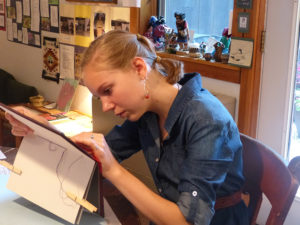Word and Image
by Tony Gengarelly

Ella Bathory Peeler at The Poetry Studio
(Excerpted text from Another World: Poetry and Art by Young People from The Poetry Studio [Luminare Press, 2021], pp. 18-27)
Another World features a selection of drawings, paintings, and decorative presentations that complement the creative practice that takes place at The Poetry Studio, where art supports the expression of language and language inspires art. The studio’s walls are covered with students’ poetry and related artwork to serve as models of inspiration. Over the past several years, the students’ extraordinary combinations of words and images have been featured by commercial and college galleries and displayed in museums throughout southern Vermont, including Massachusetts College of Liberal Arts (fall 2017–spring 2021) and the Brattleboro Museum & Art Center (Sept. 2016–Feb. 2017).
It is important to note that there is no formal art instruction at The Poetry Studio. Rather, we facilitate the creative process by supplying appropriate materials and, when requested by the student, model images and/or stencils to help with their drawings. No comments are made that might inhibit a naturally free expression — one hears only encouraging words of support. What a student needs to say in their art is not restrained by the teacher’s idea of what is “good or bad” use of color or line or proportion or visual accuracy. Viktor Lowenfeld’s seminal study of the development of young people’s art, Creative and Mental Growth, concludes that “every child is born creative” and needs to be free to develop that creativity: “[A]rt has been traditionally interpreted as relating to the study of aesthetics, and this concept has in some cases limited the opportunity for art to be used in its fullest sense. . . . It is the child’s process — his thinking, his perceiving, his reaction to his environment that is important.” This kind of unfettered visual expression — the result of an uninterrupted need to communicate — naturally becomes a partner in the creation of a poem.
Illustration
During the studio’s after-school programs in the fall and spring, an art table is set up to serve the students’ need to draw and paint as they create their poems. Sometimes a student will first experiment with an idea for a poem through a drawing or painting. Most always the students enjoy illustrating their poems and spend quite a bit of focused time with one or two pictures that complement their writing.
These illustrations will most often reiterate aspects of the poems’ content in a free and inventive style, thereby reinforcing their meaning. At times, the art will help to complete the poem with the use of images to expand necessary details or infuse emotions into the words.
The week-long summer workshops at the Studio also provide many opportunities for illustration, with three art tables available and a larger variety of materials as well as stylistic models to use. Examples are drawn from illustrated books such as Eric Carle’s marvelous renditions, and the 1890s book and poster movement (Art Nouveau designs), among many others.
Decoration and Design
Encouraged by young people’s love of illustrated books and by their highly acute visual literacy; inspired by an exhibit of illuminated manuscripts from a visit to the Morgan Library and by my own interest in graphic design, several years ago I introduced into the summer sessions a special class on the creation of “beautiful books” in order to showcase the poetry and art created during the week. These books are handcrafted with careful management of the process, which includes gluing the parts of a cover together and sewing in pages. Careful instruction with step-by-step directions is given throughout. Nonetheless, the student creator selects the book paper and waxed thread to use, decorates the cover, creates the title page, and determines the way the poetry and art are displayed on the book’s pages. Books have ranged from hard cover folios to signature sewn fold-over paperbacks to hardcover editions with diamond-patterned spines.
The book project also affords the opportunity for the invention of decorative and creative applications: border designs that illustrate as well as showcase the poems; broken text with collage applications that exude a kinetic energy and often combine illustration and decoration; combinations of text and imagery to create a new and exciting version of a poem, and title pages of arresting originality The students’ books have therefore become more than vessels to hold poems and images; their carefully fabricated covers and pages have been transformed by students into works of art.



